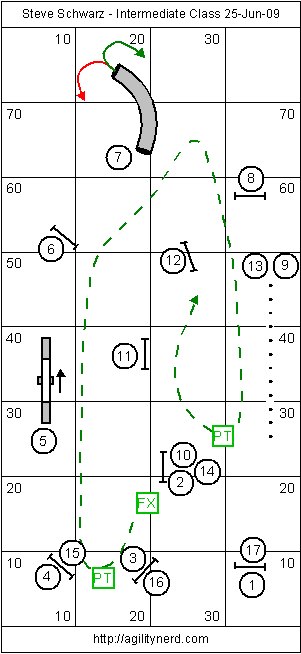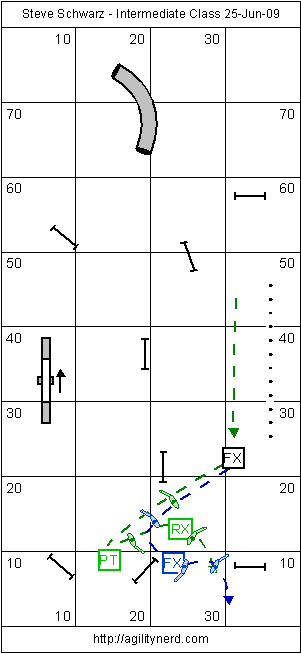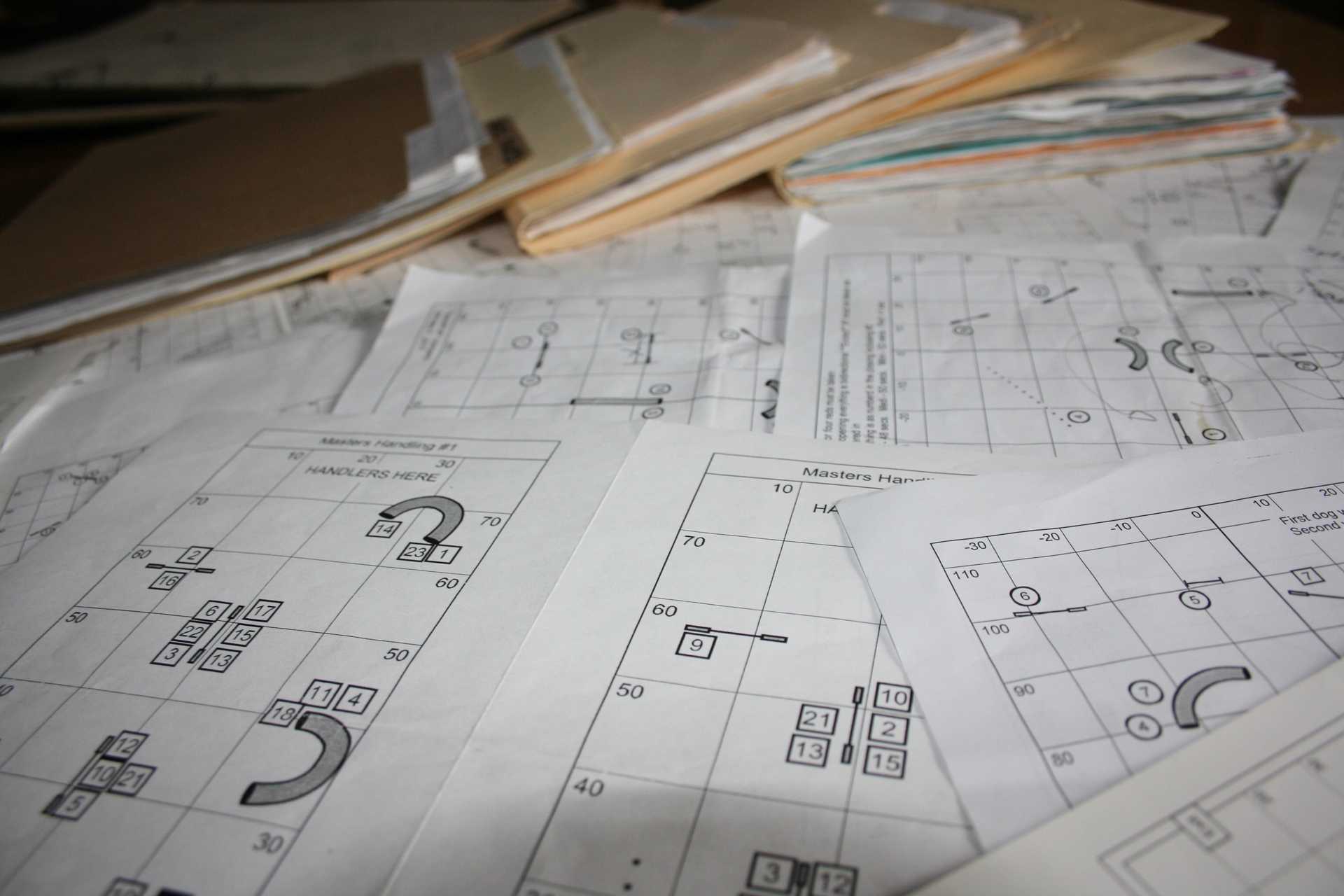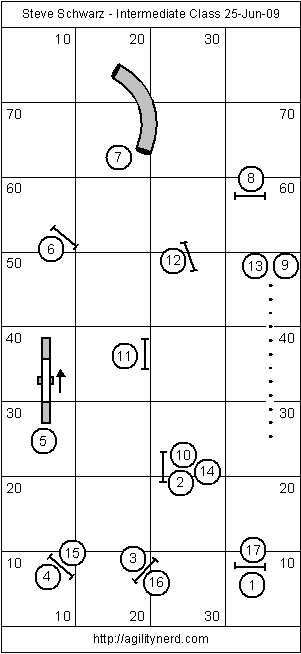Intermediate Class - 2009-Jun-24
25 Jun 2009
Here is last night’s “spur of the moment” intermediate class course, it gives some “city and highway driving”, 270 Mr Peabody in UKC Bloodlines MagazineHandling 270 Degree Jump SequencesBack Side Entry to 270/Training Opportunity - Video270 Degree Jump Sequences, a Pin Wheel, and turning the dog “the wrong way” out of a tunnel. Here’s the layout:
Handing Thoughts
This course is pretty straight forward with the beginning and end being the most difficult and interesting sections. For practice courses sometimes I like to setup a challenging closing sequence so you can get used to switching into that mind set after running a flowing open section.
Handling the Opening

On the opening everyone started with the dog on their right and either taking a Lead Out to the Front Cross Line Using the Handler Line - Front/Rear/Blind Cross LineHandler Line - Front/Rear/Blind Cross Line on the landing side of jump 2 or running to the location for a Front Cross Learning the Front Cross - VideoFront Cross. The key point is to cue “relative” collection and stay on the Front Cross line. Moving further from the line only adds distance to the dog’s path and makes it more difficult for the dog to get through the 270 (you want the dog taking jump 3 in the direction of jump 4 rather than taking jump 3 toward jump 1).
Once the dog is over jump 3 the most successful handling was just to Shoulder Pull/Post Turn Learning the Post TurnPost Turn/Shoulder Pull/Pivot Turn the dog through the 270. It had been a while since these students had worked on 270s in a sequence like this and some had to rediscover the amount of support their dogs needed to smoothly stay to the outside of the jump. I played with crossing on the take off side of jump 4 and then handling the approach to the teeter with Meeker on my right but it wasn’t a good option.
Teeter to jump 6 to the tunnel was simple, for everyone but me. I had the spacing set up such that I really had to cue jump 6 or Meeker just wouldn’t take it. He was going straight for the tunnel.
As the diagram above shows, one of the reasons I turned the tunnel to the left was to have handlers (re)learn how a dog’s lead affect how it turns out of a curved tunnel and that tunnels aren’t sound proof. Curved tunnels don’t allow dogs to change their Lead while they are in the curved part of the tunnel. Since this tunnel turns to the left, when the dog comes out of the tunnel their default behavior will be to turn to their left. So it is up to the handler to cue their dog to turn to the right as soon as they come out of the tunnel.
There are two primary cues: the dog seeing the handler on their right when they entered the tunnel and the handler calling the dog while the dog is still in the tunnel. For most dogs this worked perfectly, the unsuccessful handlers typically were silent until their dogs exited the tunnel. For more discussion on turning dogs and tunnels I have an older article here.
So once the dog is turned toward jump 8 it is an on side weave entry. You can play with the location of jump 8 to increase the difficulty of both the weave entrance and it’s off course influence when dogs go from jump 12 back to the weaves.
From the weaves it is a pretty simple three jump sequence with a little push out to the middle jump. That push makes it easier to get to jump 12. As I mentioned jump 8 can be an off course for handlers driving hard and cueing extension. I was glad to see all the students nailing the weave entrance. It is one where more novice dogs will need some assistance from the handlers in setting up their approach.

So now that the country driving is done it is a little twisty as we go to the finish line. There were two primary handling methods (shown in green and blue in the diagram above). Get a little lateral distance from the weave poles and Front Cross the exit to get the dog on the handler’s right.
The green line handler would move into “the pocket” between 15 and 16 and Post Turn/Shoulder Pull the dog around (just like in the opening). This time it is important to be a little patient before trying to turn the dog to the final jump. A number of handlers Rear Crossed immediately after their dog cleared jump 16 and that caused the dog to run by jump 17. So a little patience is needed to move the dog past jump 16.
The alternate handling is a little hard to describe but ended up being the smoother feeling approach [Landing Side 270 Front Cross]. As the blue line shows, don’t go all the way into the pocket. Go in only deep enough so that your dog commits to jump 15. Then as your dog turns toward the back of jump 16 you turn with them. As the dog is approaching the upright of jump 16 the handler Front Crosses to put the dog on their left arm. The handler then moves forward as the dog takes the jump on their left arm. Then it is just a Shoulder Pull to bring the dog over the final jump. The key is a dog that will send enough so the handler doesn’t get stuck on the landing side of jump 16.
So please let me know if you give this course a try and how you handled it!
If you enjoyed this article won't you please:  Thanks!
Thanks!

